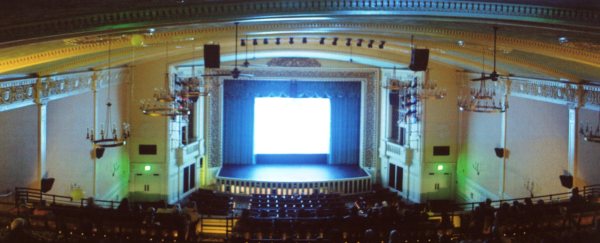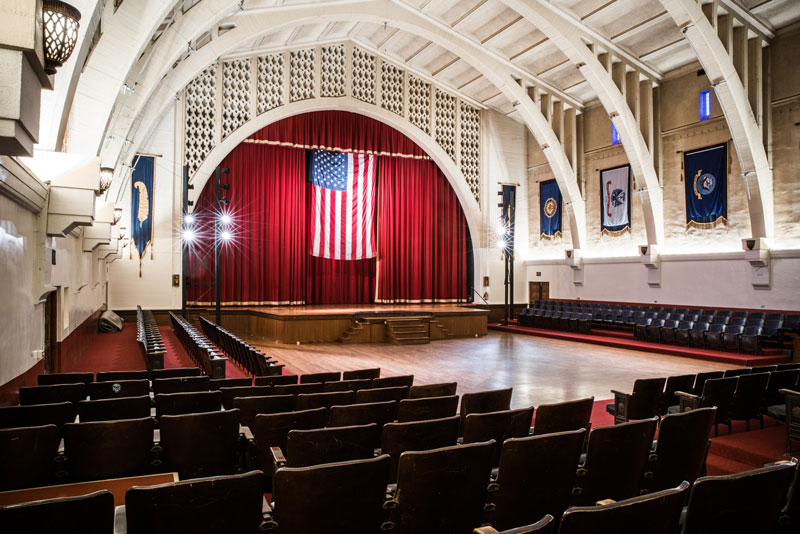|
|
This topic comprises 2 pages: 1 2
|
|
Author
|
Topic: Advice sought about image sizes in a historic theater
|
|
|
|
|
|
|
|
|
Scott Norwood
Film God

Posts: 8146
From: Boston, MA. USA (1774.21 miles northeast of Dallas)
Registered: Jun 99
|
 posted 06-05-2016 05:22 PM
posted 06-05-2016 05:22 PM





I have worked in a number of older theatres (mostly built from the late 1920s to the early 1930s) and your dimensions (screen and throw) are pretty typical. I have seen this done both ways and have a slight preference for common height in this case.
Here is a picture of an auditorium with a 13x31' common-height screen with a 113' throw (picture was taken from the booth while showing a 1.37:1 film):

The 1.37 picture is small-ish, but probably about what it would have been when the theatre originally opened (screens were smaller then). Few people sit in the balcony for films, anyway, so the picture size isn't really the issue that you might think that it is for the narrower formats.
One of the reasons I prefer common-height is that the venue above (which is mostly a performing-arts center, with occasional film programming) always shows a cartoon or short subject before the feature, and most of those are 1.37:1. It would look dumb to have the cartoon or short appear larger than the feature, which is what you would get if you maximized the image area for each format (unless you have a separate set of lenses or screen files for "1.37 short").
Having said all of that, I have seen venues that did the opposite (screen gets smaller for scope), including many that made that decision in the 1950s when scope was first installed. That works, too, especially if you don't care about screening shorts with your features (or flat trailers with scope features).
| IP: Logged
|
|
|
|
Simon Wyss
Film Handler

Posts: 80
From: Basel, BS, Switzerland
Registered: Apr 2011
|
 posted 06-06-2016 04:12 AM
posted 06-06-2016 04:12 AM




There was exactly one image aspect ratio in use in 1928, three to four. The AMPAS nominal ratio of 1:1.375 deals with the camera aperture alone, projector apertures should cut 1:1.333 out of it, slightly more laterally than longitudinally. Screens are three high and four wide since 1907. The 16-mm. image should match the same screen.
I should try to present the highest possible quality picture within the boundaries there are. I think it is more important to have the screen as free from stray light as possible which leads to a concept of either installing the 3:4 screen somewhat in front of the arch or darkening the arch with the screen in or behind it. If you can achieve a floating screen, i. e. it suspended from behind like a basketball board, you might arrive at an incredible effect. Curtains are nice to cover something but they always look silly just encircling the screen. Dark fabrics should hang behind the screen, two to three feet back.
CinemaScope. A bold solution could be a curved screen popping out of the arch. It would fit in between stage floor and arch with a foot of room between each of them and extend over the opening to both sides. One would need a pair of curved rails, basically. The question is where to store them when not in use. Safest solution: lowered into a pit. There are more solutions.
It can become very complicated to play a number of aspect ratios on one screen. That actually calls for a multi-duty historical cinema installation. 1.333, 1.666, 1.75, 1.85, 1:2 Superscope, 1:2.2 Todd-AO, 1:2.35 CS optical, 1:2.55 original CS.
Paper rolls, screens quick and dirty.
| IP: Logged
|
|
|
|
|
|
|
|
|
|
|
|
|
|
|
|
|
|
|
|
All times are Central (GMT -6:00)
|
This topic comprises 2 pages: 1 2
|
Powered by Infopop Corporation
UBB.classicTM
6.3.1.2
The Film-Tech Forums are designed for various members related to the cinema industry to express their opinions, viewpoints and testimonials on various products, services and events based upon speculation, personal knowledge and factual information through use, therefore all views represented here allow no liability upon the publishers of this web site and the owners of said views assume no liability for any ill will resulting from these postings. The posts made here are for educational as well as entertainment purposes and as such anyone viewing this portion of the website must accept these views as statements of the author of that opinion
and agrees to release the authors from any and all liability.
|

 Home
Home
 Products
Products
 Store
Store
 Forum
Forum
 Warehouse
Warehouse
 Contact Us
Contact Us




 Printer-friendly view of this topic
Printer-friendly view of this topic














